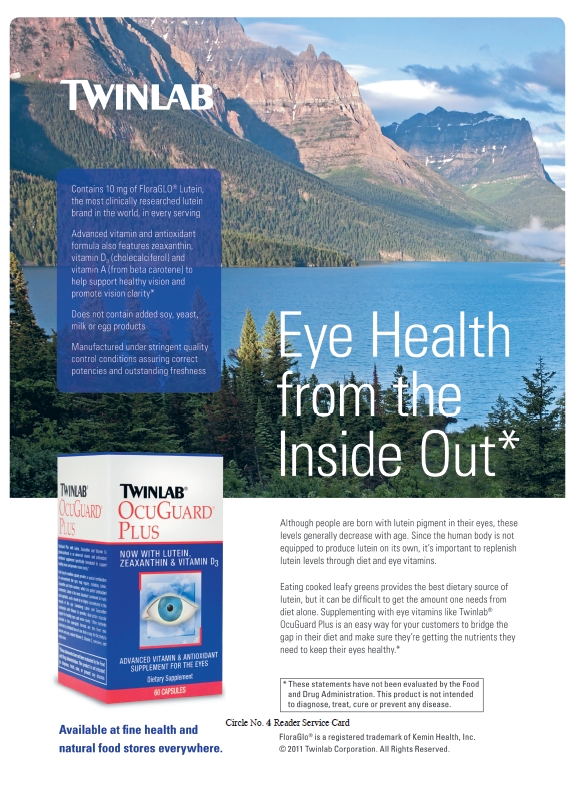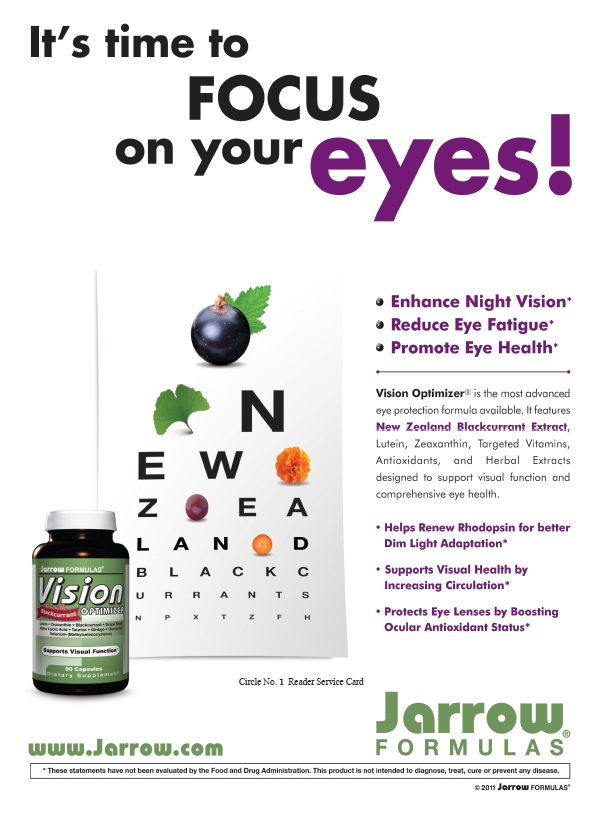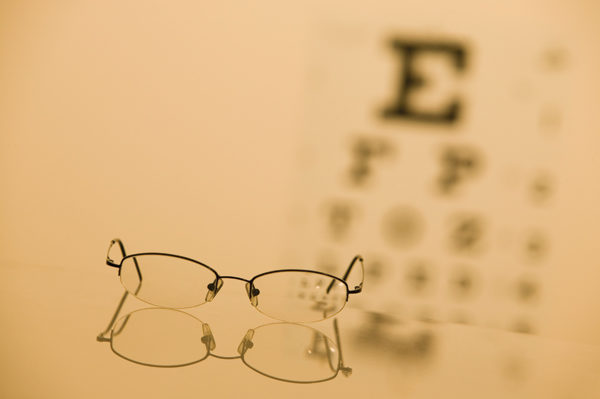A simple multivitamin delivers much of the nutrition a person’s body needs, but it might be insufficient for eye health. Studies show that higher than average levels of vitamins and minerals are needed to make a true impact on visual acuity. Thus, nutrition stores should offer eye care supplements since most people’s diets and multivitamins won’t be enough to improve their eye health.
Some people may think that eye problems are only genetic and that nutrition has nothing to do with eye health, but several studies show a direct link. An Age-Related Eye Disease Study (AREDS) conducted by the National Eye Institute in 2001 concluded that age-related macular degeneration (AMD) is a nutrition-responsive disorder (1).
To help customers pick the right nutrients for their eye health, store owners should familiarize themselves with common eye disorders. Here are a few:
•AMDis a leading cause of vision loss and blindness among older people and it is a growing problem (2). The degeneration of the macula in the retina causes central vision loss and the number of people with this disease is expected to triple in the next 10 years (2). •Cataractsare a clouding of the lens and are also related to aging. More than half of all Americans either have a cataract or have had cataract surgery by age 80 (3). • Glaucomais the second most common cause of blindness in the United States and refers to a group of eye conditions that damage the optic nerve (4). •Dry eye syndrome is another common eye health problem that occurs when the eye doesn’t make enough tears or produces poor-quality tears (5).

Some 25 million people worldwide are affected by AMD and cataracts (6), which can lead to blindness, so it is important to educate customers about what types of supplements can help prevent or reduce the risk of these eye conditions.
Macular DegenerationThe AREDS study was a major randomized, clinical trial in which 3,600 participants, 55–80 years old, were either given a placebo, an antioxidant treatment, zinc or the antioxidant and zinc combined regimen. All the doses were higher than what is a recommended daily allowance of each and participants were followed up after six years. The study found that the supplements were effective in preventing progression to advanced AMD, but that the combined zinc and antioxidant treatment, which included vitamins C, E and beta carotene, was the most effective (1).
Currently, the National Eye Institute is conducting a follow-up study, which will also look at lutein, zeaxanthin and omega-3 fatty acids. However, other studies have already shown that these are effective. A study published in the March issue of Archives of Ophthalmology found that omega-3s can prevent AMD in women. Some 38,000 women who didn’t have the disease were given a detailed questionnaire at the start of the study and 10 years later. Those who ate one or more servings of fish per week, compared with those who consumed less than one serving per month, were 30% less likely to develop AMD (7). Recently, the European Food Safety Authority stated that taking a dose of 250 mg of the omega-3 fatty acid DHA each day can contribute to healthy vision (8).
A published Lutein Antioxidant Supplementation Trial found that “patients ingesting the lutein supplement experienced significant improvements in several objective measurements of visual function including glare recovery, contrast sensitivity, and visual acuity vs. placebo [and] experienced a 50% increase in macular pigment density relative to those on placebo” (9).
Furthermore, research performed at Harvard Medical School has established that dietary zeaxanthin plays an essential role in protecting the retina from damaging effects of light (10).
 There have been studies done that show that bioflavonoids, selenium and vitamin D can also reduce the risk of advanced AMD (11).
There have been studies done that show that bioflavonoids, selenium and vitamin D can also reduce the risk of advanced AMD (11).CataractsCataract extractions are the most common surgical procedure performed in the United States (12).The same supplements that showed improvement in AMD (e.g., lutein, zeaxanthin, vitamin E, vitamin C, zinc and omega-3s) have also been found to help those with cataracts.
A Tufts University Study published in 2005 found that long term use of vitamin E and higher riboflavin or thiamin intake may reduce the progression of age-related lens opacification (13). Another study published inThe American Journal of Clinical Nutrition found that participants who took the most vitamin C and those who took an above-median quantity of vitamins C and E, ß-carotene, and zinc had a reduced risk of incident nuclear cataract (14).
Additionally, research published in a 2009 issue of Biochemistry found that carnosine, a dipeptide, has an antioxidant effect that may reduce the risk of developing cataracts. The study found that exposing the lenses of rats to carnosine restored clarity to cloudy lens tissue (15).
GlaucomaGlaucoma develops when a fluid made in the eye is blocked from flowing out, resulting in built-up pressure in the eye, which causes damage to the optic nerve. Vitamin C has been found to relieve this pressure, on average by 16 mmHg. It helps preserve the collagen in the eyes’ drainage tubes, which can malfunction in glaucoma (16). Bioflavonoids work with vitamin C to support collagen metabolism, which is important in treating glaucoma. Other studies have also found other supplements that treat glaucoma. Coleus forskohlii increased intraocular circulation and decreased aqueous humor outflow when applied directly to the eye. Researchers at the University Eye Clinic in Basel, Switzerland, gave 121.5 mg of magnesium twice a day to 10 glaucoma patients for one month and found that it improved their peripheral circulation and visual field (16).
Dry EyeSupplements also show promise for those with other less serious eye problems. For instance, more than 10 million Americans suffer from dry eye and women going through menopause are at a higher risk of developing this condition (17).
Brigham and Women’s Hospital in Boston had 32,000 women, aged 45–84, provide information on their diet, and nearly 5% of the women reported problems with dry eyes. Results showed that women who consumed the most omega-3s from fish had a 17% lower risk of suffering from dry eyes when compared to women who consumed little or no seafood (17).
Additionally, beta carotene, vitamin A and zinc have been found to reduce dry eye and night blindness (18).
Equipping your store with supplements that benefit eye health and providing sufficient information for customers will ensure they won’t be stumbling in the dark for eye health support.WF
Marianna Dworak is a freelance writer based in Scotch Plains, NJ.
References1. National Eye Institute, “Age-Related Eye Disease Study-Results,” www.nei.nih.gov/amd, accessed April 1, 2011. 2. “Age-Related Macular Degeneration,”www.allaboutvision.com/conditions/amd.htm, accessed April 1, 2011. 3. National Eye Institute, “Facts About Cataract,”www.nei.nih.gov/health/cataract, accessed April 1, 2011. 4. PubMed Health, “Glaucoma,”www.ncbi.nlm.nih.gov/pubmedhealth/PMH0002587, accessed April 1, 2011. 5. Mayo Clinic, “Dry Eyes,” www.mayoclinic.com/health/dry-eyes/DS00463, accessed April 1, 2011. 6. American Optometric Association, “Diet, Nutrition and Eye Health,”www.aoa.org/documents/nutrition/Diet_Nutrition_Eye_Health_booklet.pdf, accessed April 1, 2011. 7. W.G. Christen, et al., “Dietary Omega-3 Fatty Acid and Fish Intake and Incident Age-Related Macular Degeneration in Women,”Arch. Ophthalmol. online March 14, 2011. 8. FSA Panel on Dietetic Products, Nutrition and Allergies (NDA), “Scientific Opinion,”European Food Safety Authority Journal, 8 (10) 1796 (2010). 9. S. Richer, “Double-Masked, Placebo-Controlled, Randomized Trial of Lutein and Antioxidant Supplementation in the Intervention of Atrophic Age-Related Macular Degeneration,” Optometry, 75 (4) 216–229 (2004). 10. Macular Degeneration Support, “Study Demonstrates Essential Role of Zeaxanthin in Eye Health,”www.mdsupport.org/library/zeaxanthin.html, accessed April 1, 2011. 11. “Nutrition for Healthy Eyes,”www.allaboutvision.com/nutrition/nutrition_summary.htm, accessed April 1, 2011. 12. American Optometric Association, “Lutein and Zeaxanthin Eye-Friendly Nutrients,”www.aoa.org/documents/LuteinZeax_public.pdf, accessed April 1, 2011. 13. P.F. Jacques, “Long-Term Nutrient Intake and 5-Year Change in Nuclear Lens Opacities,”Arch. Ophthalmol. 123 (4), 517–526 (2005). 14. A.G. Tan, “Antioxidant Nutrient Intake and the Long-Term Incidence of Age-Related Cataract,” Amer.J. Clin. Nutr., 87 (6), 1899–1905, (2008). 15. F. Attanasio, “Protective Effects of L- and D-Carnosine on a-Crystallin Amyloid Fibril Formation: Implications for Cataract Disease,”Biochemistry, 48 (27), 6522–6531 (2009). 16. Life Extension, “Glaucoma,”www.lef.org/protocols/prtcls-txt/t-prtcl-053.html, accessed April 1, 2011. 17. E. Somer, American Optometric Association, “What Women Need To Know About Their Eyes,”http://aoa.org/x13399.xml, accessed April 1, 2011. 18. “Nutrition for Healthy Eyes,”www.allaboutvision.com/nutrition/nutrition_summary.htm, accessed April 1, 2011.
Published in WholeFoods Magazine, August 2011









